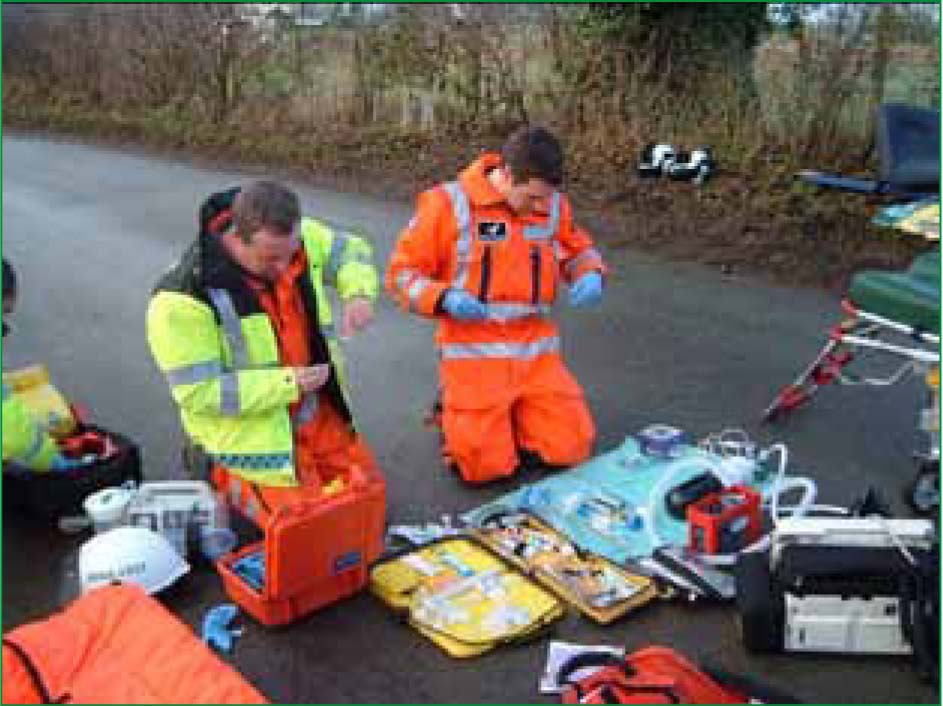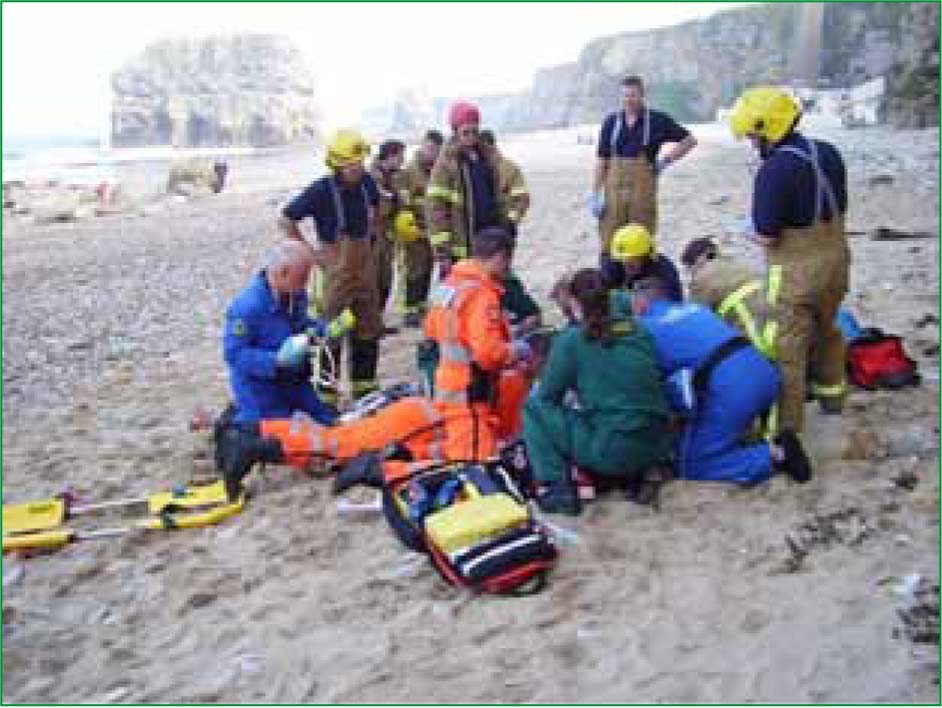Prehospital anaesthesia (PHA) is an intervention that, over the years, has had its merits debated in crew rooms. In the UK, it has now been accepted as a valuable intervention in certain patients in the prehospital environment.
There are a number of prehospital schemes in the UK with doctors who have PHA in their ‘toolbag’, and this includes the Great North Air Ambulance Service (GNAAS). In order to undertake this intervention, practitioners require more than just anaesthetic drugs and familiarity with a laryngoscope.
There are UK guidelines on PHA, agreed by all the national bodies representing practitioners who may be involved in this procedure (Association of Anaesthetists of Great Britain and Ireland; Royal College of Anaesthetists; Joint Royal Ambulances Liaison Committee; College of Emergency Medicine; British Association for Immediate Care; Faculty of Pre-hospital Care of the Royal College of Surgeons of Edinburgh and the Royal Centre for Defence Medicine).
Paramedics can, and usually do, form a critical part of the team of practitioners required when undertaking PHA. In addition to those paramedics working for an air ambulance service, road crews are increasingly likely to be involved with a patient undergoing PHA. Thus, having an understanding of the procedure and when it may be beneficial, has utility for many paramedics.
Background
The PHA guidelines were published in 2009. Four years prior to this, GNAAS decided that the simplest way to ensure its paramedics and doctors were appropriately trained to safely undertake PHA,
was to develop a course as part of the initial crew training. This was particularly important, not only for those team-members with limited anaesthetic experience, but also for those anaesthetically trained who had little or no experience of undertaking anaesthesia outside the controlled environment of a hospital.
History
‘Prehospital anaesthesia is an intervention that, over the years, has had its merits debated in crew rooms.’
The course was developed by three of the GNAAS doctors based on their experience of PHA, both in civilian and military air ambulances in the UK and overseas; in addition to their knowledge as consultant anaesthetists. The first course ran in 2005. Subsequent courses accepted paramedics and doctors from other air ambulances around the country. The course now attracts candidates from all parts of the UK and Ireland as well as from other European prehospital systems.
Structure of the course
The PHA course runs over two full days and is now held three times a year. It is currently based at Durham Tees Valley Airport where one of the two GNAAS helicopters is based. The course is open to both doctors and paramedics, and usually, but not always, those who are already working or about to start work with an Air Ambulance or BASICS scheme.
This course is designed to provide the knowledge and technique to provide safe PHA and post-intubation care. Competent basic airway management and some experience of intubation is expected prior to attending the course. Practitioners are paired up for the course, and rotate through the two roles in the system—the intubator and the assistant.
Course participants go through a series of lectures, workshops and practices prior to undergoing a rigorous afternoon of assessed moulages. The practical sessions ensure plenty of time for confidence to build during the course— there are numerous moulages on both days.
There is a very high instructor to candidate ratio, and workshops are based on a maximum of four people (the whole course runs with a maximum of 12 candidates and has a minimum of six instructors. The faculty team is made up of both paramedics and doctors, (mainly anaesthetists but also ED and an experienced BASICS GP), all of who have a wide-range of experience practising PHA. The majority of instructors work or have worked for GNAAS.
Course content
Decision-making
As with many interventions, it is not simply a matter of knowing when and how to do it, but also when not to do it. Clearly, prior to anaesthetising a patient in the prehospital environment, there are a number of decisions to be made. These decisions are informed by the patient’s condition, the environment, the team, and the time and nature of the journey to definitive care. The assessment also requires an understanding of both indications and contra-indications. The factors for consideration follow the familiar ABCDE structure to aid in the decision-making process.
A System for PHA
Once it is established that the patient requires anaesthesia, a set sequence of events is taught (Box 2). The ‘six P’s’ describe a system that is designed to maximize the safety of a potentially risky intervention from the decision point to the final elements of packaging the patient for transport.

Crew resource management
The course also teaches the importance of crew resource management. Teamworking, role allocation and appropriate use of other emergency service personnel are all discussed. In addition, there is emphasis on using a ‘challenge-response’ checklist prior to anaesthetising a patient.
Outside the safety of a hospital anaesthetic room, it is easy to forget important items of equipment when preparing for RSI. Having to find kit whilst the patient regurgitates and there is no suction immediately available is a situation that no-one wants or needs to be in.
Challenge-response checklist
In order to prepare for PHA, a suitable area of the environment must be converted into an impromptu anaesthetics room. The GNAAS system achieves much of this by use of the kit dump—a concept familiar to anyone who has worked with the fire and rescue services. Setting this up is often performed independently by the team-members, but checking the kit is done by both in tandem.
One person calls out the item from the list, and both practitioners confirm its location. This challenge–response technique derives from the air industry and ensures that prior to undertaking the procedure, both practitioners are confident that all of the equipment and drugs are ready and to hand.
Drugs
In addition to a lecture where the basic pharmacology and doses of the commonly used drugs in PHA are explained, a separate workshop allows further discussion of the practicalities of using these drugs, including practice drawing up and preparing them. Be reassured there is not enough time for an in-depth pharmacology course.
Cricoid pressure, C-spine immobilization and intubation position
This station discusses the benefits (or not) of cricoid pressure including the pitfalls and an opportunity to practice. It also looks at the options for C-spine control and the pros and cons of different intubating positions in the prehospital environment.
Monitoring and ventilation
Although most prehospital practitioners are familiar with standard monitoring (albeit perhaps different manufacturers), the monitoring of end-tidal CO2 is perhaps not so familiar. In addition, the options for ventilation and various ventilator settings are covered.
Analgesia
Morphine and entonox are familiar to most. The options of utilizing ketamine or fentanyl may not be available to all, but knowledge of the benefits (and possible side-effects) of each is certainly useful. The potential to use these drugs for immediate pain relief by the intra-nasal route, particularly in children, is new to many.
Paediatrics and pregnancy
Two patient groups that tend to increase the adrenaline levels more than most are children and pregnant patients. The salient issues as far as PHA is concerned are covered in a workshop. The threshold for PHA in children remains higher than in adults for most situations.
Failed intubation
Although good preparation should make failed intubation less likely, it does still happen even for the most experienced practitioner. This in itself is not a problem, as long as there is a well-rehearsed plan for the team to fall back on.
This uncomfortable scenario is covered in both a lecture and practice moulages. In addition, there is a separate skill station where surgical cricothyroidotomy can be practiced on a sheep larynx model.
Post-intubation management
Although the successful intubation of a casualty is often the main concern when considering PHA, probably more important is what occurs afterwards. Post-intubation management can ensure an optimized patient is delivered to the appropriate hospital, but if badly done, can result in increased morbidity and even mortality. A lecture and subsequent moulage practice stress the importance of good post-intubation management in order to ensure a high standard of what is essentially prehospital ‘critical care’.
Adverse event management
Despite everyone’s best efforts, and ‘ideal’ post-intubation management, there are times when things go wrong or deteriorate during the transfer into hospital. A system for dealing with most eventualities is taught and then reinforced with further moulage practice. There is also an opportunity to practice thoracostomy on a sheep thorax model.
Haemorrhage control, techniques and equipment for pelvic splintage and intra-osseous access are also discussed informally in small groups as background activity to the moulages.
Moulages
There are many moulages throughout the two days of the PHA course. These start simply with ‘slow-time’ scenarios, to allow familiarization with the process. The repeated practice of the GNAAS system over the two days encourages practitioners to experience the different roles involved in PHA. Over the course, more is asked of the team in terms of; the clinical scenarios, the environment and particularly the teamwork of each pair.
The final assessments include the local fire service, vehicle extrication and ambulance transfer. By the end, the two practitioners should be working together as a slick and effective prehospital team. Teamwork is key to the system and when combined with knowledge and experience, it will enhance both the speed and, importantly, the safety of the whole process.
Conclusion
This course is an excellent way of undertaking continuous professional development at the extremes of paramedic practice. Although clearly aimed at delivering PHA, it also serves as a reminder that good airway management, and effective teamwork are as important as advanced skills for a patient in the prehospital environment.
It is certainly very useful for those about to work or already working with an air ambulance service, but will also be of interest for paramedics who find themselves assisting in PHA in the region they work in.
For those wishing to take some of the courses and diplomas in advanced practice; for example the Royal College of Surgeons of Edinburgh Diploma in Immediate Care, it can serve as an excellent source of knowledge and skills in areas that are beyond standard paramedic practice here in the UK.

For further information about the GNAAS prehospital anaesthesia course, please email Marguerite Craig at: mags@greatnorthairambulance.co.uk
